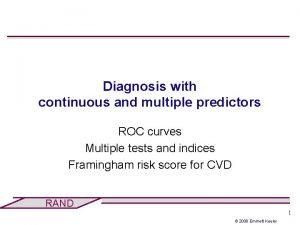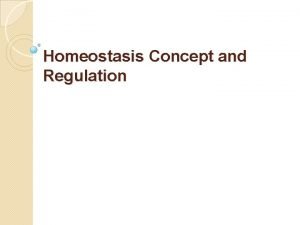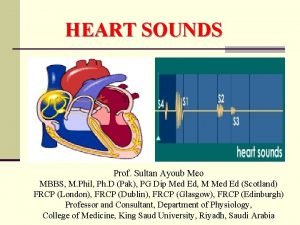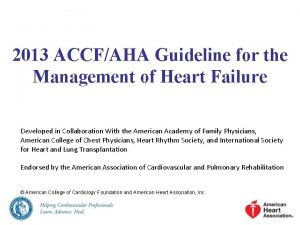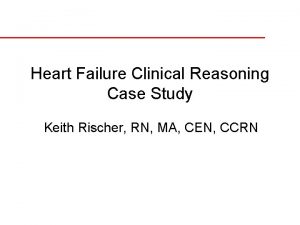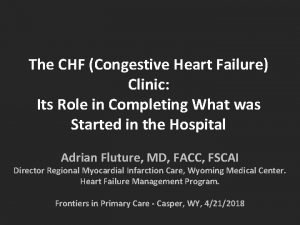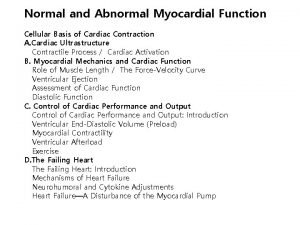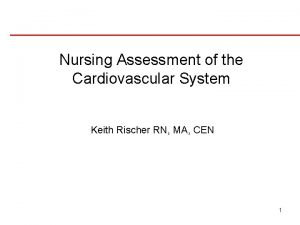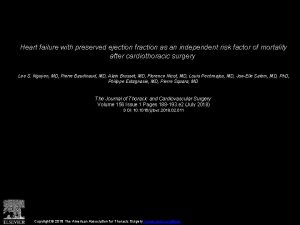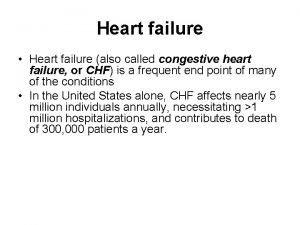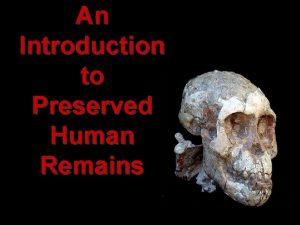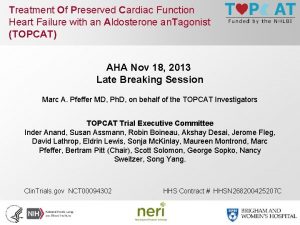Predictors of Incident Heart Failure with Preserved Ejection




























- Slides: 28

Predictors of Incident Heart Failure with Preserved Ejection Fraction: The Multi-Ethnic Study of Atherosclerosis Michael G. Silverman, MD 1 Birju S. Patel, MD MPH 2 Ron Blankstein, MD 1 João A. C. Lima, MD 3 Roger S. Blumenthal, MD 3, 4 Khurram Nasir, MD MPH 3, 4 Michael J. Blaha, MD MPH 3, 4 1 Brigham and Women’s Hospital 2 University of Texas Southwestern 3 Johns Hopkins University School of Medicine 4 Johns Hopkins Ciccarone Center for the Prevention of Heart Disease

Background • Nearly 50% of all patients with congestive heart failure (CHF) have preserved Ejection Fraction (EF) • Prevalence of Heart Failure with preserved EF (HFp. EF) has increased over time, now estimated at 1 – 5% • Associated with significant morbidity and mortality • No specific therapy for HFp. EF Lam C, et al. Epidemiology and clinical course of heart failure with preserved ejection fraction. Eur J Heart Failure 2011; 13: 18 -28 2

Background • HFp. EF is a heterogeneous condition • Need to understand pathophysiology of HFp. EF – there is no animal model • Better phenotypic characterization is needed • Important to identify and characterize risk factors for incident HFp. EF Shah A, Pfeffer M. The many faces of heart failure with preserved ejection fraction. Nat. Rev. Cardiol 2012; 9: 555 -556 3

Background • Several prior studies have characterized patients already diagnosed with HFp. EF (ex: ARIC) • Only 1 study has evaluated risk factors associated with developing incident HFp. EF • Limited to a single center ethnically homogeneous population (Framingham Heart Study) 4 Ho JE et al. Predictors of New-Onset Heart Failure – Differences in Preserved Versus Reduced Ejection Fraction. Circ Heart Fail 2013; 6: 279 -86.

Study Objectives Study Aim: • Characterize the risk factors – including ethnicity – associated with incident HFp. EF in a multi-ethnic cohort. Hypotheses 1) The risk factor profile for HFp. EF will be different from the risk factor profile for HF reduced EF (HFr. EF) 2) Incidence of HFp. EF will differ by race/ethnicity 5

Primary Outcome • • • HFp. EF – clinical diagnosis of HF with EF ≥ 45% HFr. EF – clinical diagnosis of HF with EF < 45% (First) Incident CHF is an adjudicated endpoint requiring the following criteria: • • Symptoms of pulmonary congestion or edema Physician diagnosis and medical treatment for HF Evidence from chest x-ray or echocardiography EF is a clinical outcome collected from hospital records at time of CHF diagnosis 6

Analysis • Evaluate association of race/ethnicity with incident HFp. EF/HFr. EF using Cox proportional hazards models Forward selection of risk factors • • • Demographic Clinical history Laboratory Imaging 7

Study Population 6814 in baseline cohort -Excluded for missing information (n=35) - Developed CHF, unable to classify EF (n=35) 6744 in final cohort - 5540 in NT-pro. BNP subset - 4956 in MRI subset Individuals were followed for median 10. 2 (9. 7 -10. 7) years 103 individuals developed incident HFp. EF 95 individuals developed incident HFr. EF 8

Baseline Characteristics by Outcome Demographic Information Variable HFp. EF n = 103 HFr. EF n = 95 No HF n = 6546 Age 70 (± 9) 67 (± 9) 62 (± 10) Male 50% 72% 47% White 45% 39% 38% Chinese 11% 0 12% Black 23% 43% 28% Hispanic 21% 18% 22% Race/ethnicity 9

Baseline Characteristics by Outcome Clinical History Variable HFp. EF n = 103 HFr. EF n = 95 No HF n = 6546 Hypertension 73% 72% 44% BMI (kg/m 2) 30 (± 6) 29 (± 5) 28 (± 5) Diabetes 32% 29% 12% Current Smoker 13% 21% 13% LVH by EKG 5% 5% 1% Incident MI 13% 12% 2% 10

Baseline Characteristics by Outcome Laboratory and Imaging Data Variable HFp. EF n = 103 HFr. EF n = 95 No HF n = 6546 Total cholesterol (mg/d. L) 188 (± 34) 187 (± 35) 194 (± 36) HDL cholesterol (mg/d. L) 49 (± 15) 47 (± 13) 51 (± 15) e. GFR (ml/min/1. 73 m 2 BSA) 71 (± 18) 70 (± 20) 78 (± 16) hs-CRP (mg/L) 2. 7 (1. 1 – 6. 4) 3. 3 (1. 2 – 6. 3) 1. 9 (0. 8 – 4. 2) NT-pro. BNP (pg/m. L) 139 (77 – 254) 181 (81 – 375) 53 (23 – 108) EF by MRI 70 (± 8) 58 (± 12) 69 (± 7) CAC > 0 69% 73% 49% 11

10 Distribution of Ejection Fraction 5 Frequency (%) 15 Incident HF 20 40 60 Ejection fraction (%) 80 12

Incident HF HFp. EF n = 103 (1. 5%) HFr. EF n = 95 (1. 4%) 1 Cumulative CHF incidence (%) 2 Cumulative CHF Incidence 3 6 Follow-up year 9 13

Incident HF Incidence rates of HFp. EF by race/ethnicity CHF incidence / 1, 000 person-years 4 3 2 1 1. 8 1. 4 1. 6 Chinese Black Hispanic 24 (1. 3%) 22 (1. 5%) 0 White HFPEF n = 46 (1. 8%) 11 (1. 4%) 14

Multivariable adjusted HR Demographic Information Variable HFp. EF HFr. EF HR* 95% CI, p value HR* 95% CI Age 2. 5 1. 9 – 3. 3 p < 0. 001 1. 5 1. 1 – 1. 9 p = 0. 008 Male 1. 1 0. 7 – 1. 7 p = 0. 68 2. 6 1. 6 – 4. 2 p < 0. 001 -- -- Race/ethnicity White ref -- -- Ref Chinese 1. 4 0. 6 – 3. 3 p = 0. 4 ** Black 0. 6 0. 3 – 1. 1 p = 0. 08 1. 7 1. 0 – 2. 9 p = 0. 045 Hispanic 0. 8 0. 4 – 1. 5 p = 0. 5 0. 8 0. 4 – 1. 6 p = 0. 5 • p < 0. 05 highlighted in bold if significant for both HFp. EF and HFr. EF, green text if HFp. EF only, blue text if HFr. EF only • *Adjusted for age, gender, race/ethnicity, MESA site, socioeconomic status, smoking, diabetes, hypertension, LVH by EKG, obesity, e. GFR, coronary artery calcium, total cholesterol, abnormal HDL cholesterol, and incident MI. • ** no Chinese individuals developed incident HFr. EF 15

Multivariable adjusted HR Clinical History Variable HFp. EF HFr. EF HR* 95% CI, p value HR* 95% CI Hypertension 1. 8 1. 1 – 2. 8 p = 0. 02 1. 8 1. 1 – 2. 9 p = 0. 02 BMI (per SD) 1. 4 1. 2 – 1. 8 p = 0. 001 1. 1 0. 9 – 1. 4 p = 0. 4 Diabetes 2. 7 1. 8 – 4. 3 p < 0. 001 2. 5 1. 5 – 4. 0 p < 0. 001 Current Smoker 2. 0 1. 1 – 3. 7 p = 0. 03 2. 5 1. 5 – 4. 2 p = 0. 001 LVH by EKG 4. 3 1. 7 – 10. 7 p = 0. 002 4. 4 1. 8 – 11. 2 p = 0. 002 Incident MI 4. 9 2. 7 – 9. 0 3. 8 2. 0 – 7. 3 p < 0. 001 • p < 0. 05 highlighted in bold if significant for both HFp. EF and HFr. EF, green text if HFp. EF only, blue text if HFr. EF only • *Adjusted for age, gender, race/ethnicity, MESA site, socioeconomic status, smoking, diabetes, hypertension, LVH by EKG, obesity, e. GFR, coronary artery calcium, total cholesterol, abnormal HDL cholesterol, and incident MI. 16

Multivariable adjusted HR Laboratory and Imaging Data Variable HFp. EF HFr. EF HR* 95% CI, p value HR* 95% CI p value Total cholesterol (per SD) 0. 9 0. 8 – 1. 2 p = 0. 6 0. 9 0. 8 – 1. 2 p = 0. 06 Low HDL-Cholesterol 1. 1 0. 7 – 1. 7 p = 0. 6 0. 8 0. 5 – 1. 3 p = 0. 4 e. GFR (per SD decrease) 1. 0 0. 8 – 1. 2 p = 0. 95 1. 3 1. 1 – 1. 6 p 0. 004 CAC > 0 0. 9 0. 6 – 1. 5 p = 0. 8 1. 3 0. 8 – 2. 2 p = 0. 3 NT-pro. BNP > 75 th % ile 3. 6 2. 2 – 6. 0 p < 0. 001 5. 6 3. 2 – 9. 6 p < 0. 001 LV mass index (per SD) 1. 4 1. 1 – 1. 8 p = 0. 004 2. 0 1. 8 – 2. 4 p < 0. 001 • p < 0. 05 highlighted in bold if significant for both HFp. EF and HFr. EF, green text if HFp. EF only, blue text if HFr. EF only • *Adjusted for age, gender, race/ethnicity, MESA site, socioeconomic status, smoking, diabetes, hypertension, LVH by EKG, obesity, e. GFR, coronary artery calcium, total cholesterol, abnormal HDL cholesterol, and incident MI. 17

Limitations • EF was obtained from chart review of hospitalizations, not via centralized core lab reviewing echo images • • • no set protocol for EF evaluation when diagnosis made There were non-classifiable CHF events due to varying EF reporting in the hospital documentation Small number of events, limited sample size formal interaction testing within ethnicities 18

Conclusions • There are significant risk factors for HFp. EF, most of which overlap with HFr. EF • • • Older Age Hypertension Diabetes Current smoking LVH by EKG Incident MI Higher NT-pro. BNP Higher LV mass index by MRI BMI was associated with increased risk for incident HFp. EF but not HFr. EF 19

Conclusions • Non-significant univariate predictors: • • gender race/ethnicity socioeconomic status (level of education) elevated hs-CRP (> 2 mg/L) Elevated triglycerides, Increased heart rate Significant univariate but non-significant multivariate predictors: • • • pulse pressure total cholesterol CAC > 0 20

Conclusions • There is overlap with risk factors identified for incident HFp. EF in prior analysis from Framingham Heart Study (FHS) • • • Older Age, Diabetes, BMI, Smoking Gender was not a significant predictor of HFp. EF in FHS either Race/Ethnicity was not a significant predictor of HFp. EF • Formal interaction testing between race/ethnicity and HFp. EF was negative 21 Ho JE et al. Predictors of New-Onset Heart Failure – Differences in Preserved Versus Reduced Ejection Fraction. Circ Heart Fail 2013; 6: 279 -86.

Conclusions • Future Directions • • Goal of this study is find the “standard” risks factors for HFp. EF, guide future analyses in MESA Evaluate additional predictors for HFp. EF to better characterize pathophysiology • • Metabolic and lifestyle parameters Serologic markers Imaging parameters Need for larger sample size for increased power to better characterize difference in risk factors by ethnicity 22

Acknowledgements • • • The authors thank the other investigators, the staff, and the participants of the MESA study for their valuable contributions. A full list of participating MESA investigators and institutions can be found at http: //www. mesa-nhlbi. org. We wish to thank all the MESA volunteer research participants who made this study possible This research was supported by contracts R 01 HL 071739, N 01 -HC-95159 through N 01 -HC-95165, and N 01 -HC 95169 from the National Heart, Lung, and Blood Institute. 23

Thank You 24

25

26

27

28
 Roc curve with multiple predictors
Roc curve with multiple predictors Failure to sense vs failure to capture
Failure to sense vs failure to capture Ductile break
Ductile break Ventricular escape rhythm
Ventricular escape rhythm Corfu incident league of nations failure
Corfu incident league of nations failure Milk ejection reflex flowchart
Milk ejection reflex flowchart Machinary murmur
Machinary murmur Classification of ejection fraction
Classification of ejection fraction Ejection fraction vs stroke volume
Ejection fraction vs stroke volume Heart sounds location
Heart sounds location Ejection fraction vs stroke volume
Ejection fraction vs stroke volume Classification of ejection fraction
Classification of ejection fraction Stroke volume normal
Stroke volume normal Grade murmur 1-6
Grade murmur 1-6 Incident objectives that drive incident operations
Incident objectives that drive incident operations Chapter 24 heart failure drugs
Chapter 24 heart failure drugs Diabetes and heart failure
Diabetes and heart failure Keith rn heart failure case study
Keith rn heart failure case study Edema assessment
Edema assessment Dr nienkemper
Dr nienkemper Compensatory mechanism of heart failure
Compensatory mechanism of heart failure Heart failure
Heart failure Forrester classification heart failure
Forrester classification heart failure Compensatory mechanisms of heart failure
Compensatory mechanisms of heart failure Donkey analogy heart failure
Donkey analogy heart failure Right sided heart failure
Right sided heart failure Congestive heart failure zones for management
Congestive heart failure zones for management Heart failure definition
Heart failure definition Apetm heart sounds
Apetm heart sounds
